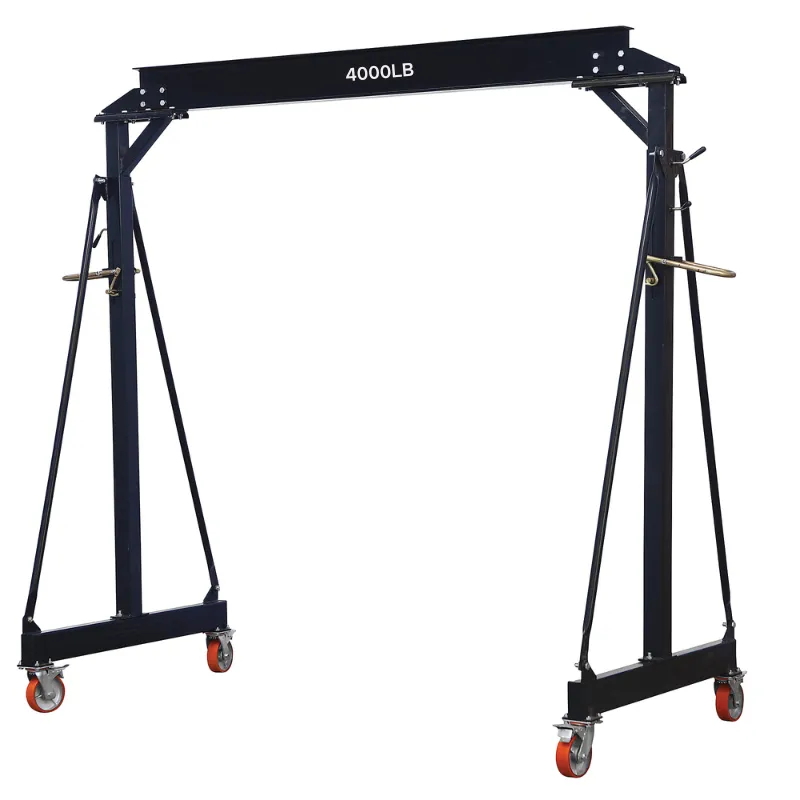movable gantry crane
Understanding Movable Gantry Cranes An Essential Tool in Heavy Lifting
Movable gantry cranes are a vital piece of equipment in various industries, notably construction, manufacturing, and shipping. These cranes are designed to lift and move heavy loads efficiently and safely, making them indispensable in settings where heavy materials need to be transported across significant distances.
What is a Movable Gantry Crane?
A movable gantry crane typically consists of a structure with two vertical supports, known as legs, connected by a horizontal beam. This design allows for substantial lifting capability while providing stability. Unlike traditional overhead cranes, which are fixed in position, gantry cranes can move along tracks or even on wheels, making them versatile tools for various applications.
These cranes can be powered either manually or via electric systems, facilitating operations in different environments, from outdoor construction sites to indoor warehouses. Their configuration allows them to navigate easily around obstacles and fit into tight spaces, which is often a limitation for fixed cranes.
Advantages of Movable Gantry Cranes
1. Flexibility The ability to move from one location to another is perhaps the most significant advantage of movable gantry cranes. This feature allows businesses to optimize workflows by moving the crane to different operational areas as needed without having to relocate heavy equipment.
2. Cost-Effectiveness Investing in a movable gantry crane can often prove to be more economical than installing multiple fixed cranes. With just one piece of equipment, companies can handle various tasks and loads, reducing overhead costs.
3. Easy Setup and Operation Movable gantry cranes are often easier to set up than their fixed counterparts. They can be assembled quickly without extensive groundwork or structural support, allowing for faster project initiation.
movable gantry crane

4. Enhanced Safety These cranes come equipped with safety features such as emergency stops, overload protection systems, and safety locks. This ensures that operations involving heavy lifting are conducted with minimized risks to workers and equipment.
5. Adaptability to Load Requirements Movable gantry cranes can be customized to suit specific load requirements. Different types of hoists and attachments can be added to accommodate the particular needs of a project, further enhancing their utility.
Applications of Movable Gantry Cranes
Movable gantry cranes find applications in various settings
- Construction Sites They help in lifting steel beams, concrete blocks, and other heavy construction materials, making the erecting process much more efficient. - Manufacturing Facilities They are used for assembling machinery, lifting heavy components, and moving products through different stages of the manufacturing process.
- Shipping Ports At ports, movable gantry cranes facilitate the loading and unloading of containers, enhancing the speed and efficiency of logistics operations.
Conclusion
In conclusion, movable gantry cranes are an essential component of modern industry, providing unmatched flexibility, safety, and cost-efficiency in lifting heavy loads. Their versatility spans across various sectors, making them an invaluable asset for any operational workflow that involves substantial weight handling. As industries continue to evolve, the demand for reliable and efficient lifting solutions like movable gantry cranes is likely to grow, driving further innovations in crane design and technology. Understanding and leveraging the capabilities of these cranes can lead to improved productivity and safer work environments across multiple fields.
-
Unlock Seamless Relocation with Our Heavy Equipment Moving ExpertiseNewsJun.06,2025
-
Unleash Unrivaled Flexibility with Our Adjustable Gantry CraneNewsJun.06,2025
-
Unleash Heavy-Duty Efficiency with Our Industrial Gantry Crane SolutionsNewsJun.06,2025
-
Revolutionize Steel Handling with Our Magnetic Lifter RangeNewsJun.06,2025
-
Master Equipment Mobility with Premium Machinery Mover SolutionsNewsJun.06,2025
-
Elevate Your Material Handling with Magnetic Lifter TechnologyNewsJun.06,2025
-
YS Permanent Lifting Magnets: The Smarter Way to Handle SteelNewsMay.22,2025
